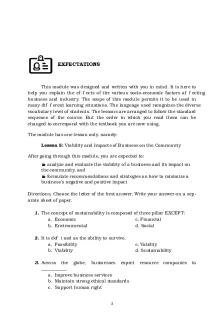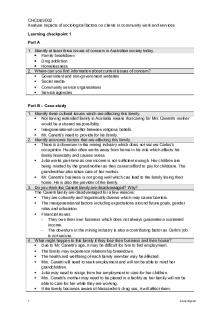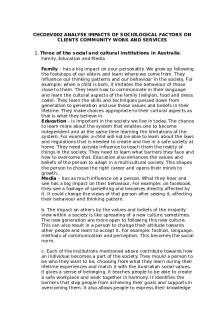CHCDEV002 Analyse impacts of sociological factors on clients in community work and services - Learning checkpoint 1-3 PDF

| Title | CHCDEV002 Analyse impacts of sociological factors on clients in community work and services - Learning checkpoint 1-3 |
|---|---|
| Course | Community Services - Case Management |
| Institution | TAFE New South Wales |
| Pages | 4 |
| File Size | 122.2 KB |
| File Type | |
| Total Downloads | 373 |
| Total Views | 576 |
Summary
Analyse impacts of sociological factors on clients in community work and servicesLearning checkpoint 1Part A Identify at least three issues of concern in Australian society today. Family breakdown Drug addiction Homelessness Where can you find information about current issues of concern? Gov...
Description
CHCDEV002 Analyse impacts of sociological factors on clients in community work and services Learning checkpoint 1 Part A 1. Identify at least three issues of concern in Australian society today. Family breakdown Drug addiction Homelessness 2. Where can you find information about current issues of concern? Government and non-government websites Social media Community service organisations Service agencies Part B – Case study 1. Identify three cultural issues which are affecting this family. Not having extended family in Australia means that caring for Mrs Canetti’s mother would be a shared responsibility. Intergenerational conflict between religious beliefs. Mr. Canetti’s need to provide for his family. 2. Identify economic factors that are affecting this family. There is a downturn in the mining industry which does not secure Carlos’s occupation. He also often works away from home in his role which affects his family financially and causes stress. Julia works part-time as one income is not sufficient enough. Her children are being minded by the grandmother as they cannot afford to pay for childcare. The grandmother also takes care of her mother. Mr. Canetti’s business is not going well which can lead to the family losing their home. He is also the provider of the family. 3. Do you think the Canetti family are disadvantaged? Why? The Canetti family are disadvantaged for a few reasons: They are culturally and linguistically diverse which may cause barriers. The intergenerational factors including expectations around future goals, gender roles and education. Financial issues: - They own their own business which does not always guarantee a sustained income. - The downturn in the mining industry is also a contributing factor as Carlo’s job is not secure. 4. What might happen to this family if they lose their business and their house? Due to Mr. Canetti’s age, it may be difficult for him to find employment. The family may experience relationship breakdown. The health and wellbeing of each family member may be affected. Mrs. Canetti will need to seek employment and will not be able to mind her grandchildren. Julia may need to resign from her employment to care for her children. Mrs. Canetti’s mother may need to be placed in a facility as her family will not be able to care for her while they are working. If the family becomes aware of Alessandro’s drug use, it will affect them. 1
Lena Ngoun
CHCDEV002 Analyse impacts of sociological factors on clients in community work and services 5. What major social institutions are relevant to this family’s situation? Legal systems Aged care systems Religious institutions Health systems Welfare systems e.g. Centrelink Economic institutions e.g. banks Learning checkpoint 2 Part A 1. What data could be relevant to analysing the impact of social and cultural issues on people’s lives? Areas where the issue or situation is predominant Current figures of the people affected Socioeconomic status of those affected The ages of the affected people Social factors affecting demoted population The employment status of those affected The health status of the affected people Culture and cultural practices affecting those populations that are marginalised. 2. Where could you find this data? Australian census records The Australian Bureau of Statistics Online databases and professional journals from organisations Professional associations e.g. the Australian Community Workers Association (ACWA) Government departments e.g. the Department of Social Services. Part B – Case study 1. Identify Alma’s significant health issues. Type 2 diabetes Heavy smoker Overweight High blood pressure Schizophrenia Early stages of dementia Hallucinations Respiratory infections 2. What social and environmental factors may have had negative effects on Alma’s health and wellbeing over her lifetime? Alma was an in-patient at a psychiatric hospital for 15 years due to her long-term mental health issue, schizophrenia. As a result, she did not posses any literacy skills and was never employed which has significantly impacted everything. Alma is stigmatised by the community as her only source of income is from Centrelink and she has never been employed.
2
Lena Ngoun
CHCDEV002 Analyse impacts of sociological factors on clients in community work and services Her smoking habit affects her health. She suffered from an abusive relationship and had a miscarriage due to the violence and distressing events. 3. What services can you suggest to improve Alma’s overall health and wellbeing? A case manager who provides assistance with all her issues as they will be able to organise the services she needs. An advocator. A care plan outlining all her issues. Specialised services such as counselling. Assign a GP to manage her health issues and to provide ongoing care through referrals.
Learning checkpoint 3 Part A 1. Identify three social and cultural factors which have an impact on what services are provided. Social factors include domestic violence, family violence and geographical location. Cultural factors include beliefs/values, different roles and different behaviours. 2. Choose a service provided to a group of clients in your own work role or a sample work role from a community service organization. Youth Employment Services What impact do you think your own work role or the work role you have chosen as an example has on your clients? This service supports young people between the ages of 15 to 24, providing preemployment support to improve their work-readiness and help them gain employment. It enhances the lifestyle and independence of young people. It involves ongoing assistance, mentoring, work experience and training. Does it restrict you in any way? Some clients may have disabilities or individual issues which may cause a barrier or delay in finding employment. Does it match the needs of the client? Yes. Does it support you to work effectively? Yes. How effective are the agency’s policies and procedures in supporting the work of the agency? The organisation’s policies and procedures supports the work of the agency and provides information relating to confidentiality, best practice guidelines, compliance, conduct of ethics and service users’ rights to make a complaint. It measures the efficiency of the services provided and determines whether the organisation is reaching their goals. Part B Youth Employment Services 1. Who is the program for? 3
Lena Ngoun
CHCDEV002 Analyse impacts of sociological factors on clients in community work and services Young people aged between 15 to 24 who are unemployed. 2. Identify at least two organisational policies and procedures which have an impact on the program. Confidentiality policy Work Health and Safety policy 3. Comment on the effectiveness of one of these policies and procedures in supporting the work of the program. The WHS policy keeps the workers and service users safe. 4. Looking at the cultural and social factors which affect these people, can you identify any barriers to them participating and/or fully engaging in the program? Cultural expectations Gender factor Living remotely Gender factor 5. If you can identify any barriers, or any aspects of the program which are not working, what changes can you suggest to make improvements? Language barriers – use interpreters
4
Lena Ngoun...
Similar Free PDFs

Community-Work-Report
- 56 Pages

Viability and Impacts of Business
- 12 Pages

Chapter 13 - Services Marketing
- 4 Pages
Popular Institutions
- Tinajero National High School - Annex
- Politeknik Caltex Riau
- Yokohama City University
- SGT University
- University of Al-Qadisiyah
- Divine Word College of Vigan
- Techniek College Rotterdam
- Universidade de Santiago
- Universiti Teknologi MARA Cawangan Johor Kampus Pasir Gudang
- Poltekkes Kemenkes Yogyakarta
- Baguio City National High School
- Colegio san marcos
- preparatoria uno
- Centro de Bachillerato Tecnológico Industrial y de Servicios No. 107
- Dalian Maritime University
- Quang Trung Secondary School
- Colegio Tecnológico en Informática
- Corporación Regional de Educación Superior
- Grupo CEDVA
- Dar Al Uloom University
- Centro de Estudios Preuniversitarios de la Universidad Nacional de Ingeniería
- 上智大学
- Aakash International School, Nuna Majara
- San Felipe Neri Catholic School
- Kang Chiao International School - New Taipei City
- Misamis Occidental National High School
- Institución Educativa Escuela Normal Juan Ladrilleros
- Kolehiyo ng Pantukan
- Batanes State College
- Instituto Continental
- Sekolah Menengah Kejuruan Kesehatan Kaltara (Tarakan)
- Colegio de La Inmaculada Concepcion - Cebu












